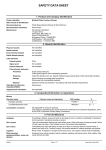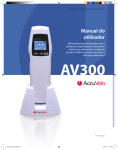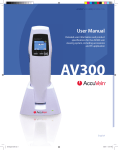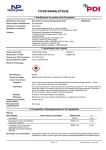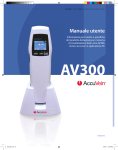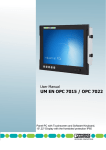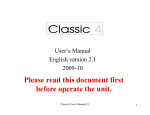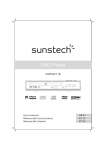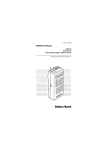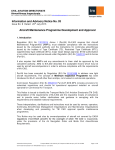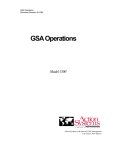Download AOPA-Sweden suggested changes to Pt. M requirements for
Transcript
AOPA-Sweden suggested changes to Pt. M requirements for continuing airworthiness regarding non-complex aircraft not used in commercial operations. Background: Since the implementation in 2008 of Part M, regulating the continuing airworthiness of aircraft and components, the General Aviation industry and aircraft owners has seen an unprecedented increase in cost and complexity of aircraft maintenance. The increases in cost and complexity are of such magnitude as to jeopardise the future of all General Aviation activities across Europe. The effects are already evident in varying degrees in the member states where technically perfect aircraft are grounded for bureaucratic reasons. The underlying principle, or idea, of the proposed changes presented here is to remove the requirement for a CAMO for Non-Complex aircraft Not used in Commercial operations (referred to as 2NC in this paper). This is achieved by replacing the individually compiled AMP’s with a set of generic physical inspections to ensure airworthiness and allowing a Part-66 person to issue the ARC. This will remove the concept of “Controlled Environment” for 2NC, if the owner chooses to maintain his aircraft along the proposed changes here. The existing rules may of course be adhered to if the owner sees them as more favourable for some reason or if he intends to conduct commercial operations. This, together with simplifications in component maintenance will probably mean that the number of Part-F shops for aircraft maintenance will diminish. There may still be a need for Part-F component maintenance shops however. While we allow a Part-66 person to do component maintenance for 2NC the requirements on cleanliness, equipment etc will of course remain and be a limiting factor. Removing the need for Part-F shops will do nothing to decrease flight safety. The work carried out by the shop is in real life done by a Part-66 person. AOPA-Sweden’s proposed changes will only mean that he does not have to spend time and money on compiling a MOM in preparation of gaining his Fapproval, nor on NAA fees and audits. Non-complex aircraft used in commercial operations are not treated in this paper as we represent owners and pilots only. We have not considered sailplanes, powered sailplanes or balloons as these categories have their own organisations. We believe that all regulatory alleviation’s valid for ELA 1 may be applied to 2NC aircraft. We foresee a repetitive AD-note list issued by the Agency and/or the NAA for each aircraft type or model, such as Piper PA28-161 or Cessna C172 as two examples. These lists will be used by the Part-66 person doing the Annual Inspection, and the applicable ADnotes will be ticked off when they are complied with. In anticipation of such a list, the AD-note list from the existing AMP’s may be used. Components with Airworthiness Limitations will still be required to have their own log cards, and the flying hours will be duly recorded. A similar list containing NAA-mandated inspections or actions is also foreseen. We simplify and clarify the airworthiness review of MA 710 so that the relevant inspections can be performed by a Part-66 person. The generic physical inspection as mentioned earlier and the airworthiness review are to be performed annually in conjunction with the renewal of the ARC. The ARC document is then issued by the Part-66 person, just like today in most cases, only now he will not need an expensive and complicated CAMO approval. The change is on paper only. We clarify what “approved maintenance data” is for 2NC, since this has been a source of confusion for NAA as well as owners of General Aviation aircraft. We remove the requirement for Pilot-Owner maintenance actions to be included in the AMP. First of all due to the individual AMP being removed, and secondly, the only person approving the Pilot-Owner to do the maintenance is the Pilot-Owner himself. Part M Appendix VIII may consequently, and without any loss of flight safety, state that any person qualified in accordance with MA 803 may perform the maintenance actions listed in said appendix. The concept of annual inspections will also allow us to increase the scope of Pilot-Owner maintenance. We have noted that some alleviation’s for ELA1 regarding owner-produced parts did not make it to Opinion 01/2011 due to not being compatible with commercial operations. We believe it is time to separate commercial and non-commercial operations and differentiate the technical requirements, as it appears to be what is needed to create at least one regulatory space where GA may continue to exist. We believe the owner of an aircraft must make his mind up if he is to retain the possibility of commercial operations in the future or not. For owners of small and/or older aircraft the choice may be easy and the only possible means to continue operation will be to stay with the 2NC regulation proposed here. Owners of older aircraft have always had to rely on used or owner-produced parts for replacements as purchase from the original producer may be impossible from an availability or cost-lead-time standpoint. There are no statistics showing this practice to be a safety issue. Therefore 21A 307 (c) 2 must be given more weight and be expanded to again include owner-produced parts and used parts. An owner-produced part may be done with the old part as a template, and the process should be documented with a simple sketch or drawing where all information on material used, surface treatment etc. is included. The limitation to exclude life limited parts, parts of the primary structure and parts of the flight controls may (again) be removed for 2NC. Although it is outside this rework of Part M, we would very much like to see a central database for ADnotes issued by NAA, EASA and the FAA. Today the search for AD-notes applicable to a particular aircraft is quite complicated as all present databases have their own, sometimes imperfect, search logic and the risk of missing an AD-note is obvious. A preferred alternative would be to update the EASA database with all historical NAA and FAA AD-notes, this time issued as EASA AD-notes. We have strived to write the proposed changes in such a way as to minimise the risk of different interpretations by the GA industry and the various NAA’s. As many has found out the hard way, there is one Part M as issued by EASA and then there is another Part-M as interpreted by the NAA. Often two quite different sets of rules. After the creation of EASA, the NAA’s no longer write the rules and they increasingly see themselves as law enforcement agencies only. As a result, their interpretations have become more strict and the aircraft owners and pilots as well as maintenance organisations are having a tough time defending reason and proportionality. In the eyes of the public, EASA is to blame for this and the name and credibility of EASA is by now rather tarnished. Perhaps the amendments we propose will change that for the better. We hope that EASA will adopt our proposed changes to Part M and that they will provide for a reasonable balance between cost and safety, and be so robust they may be in effect for many years creating a much needed stable and predictable environment for GA aircraft owners, pilots and enterprises. Indeed, we hope that the adoption of these changes will give back to the aircraft owners and pilots of Europe their favourite pastime and return the quality of their lives to where it was before 2008. Discussion: 1. Part M, Subpt. C, Continuing Airworthiness: The Continuing Airworthiness Tasks detailed in MA301 introduce to General Aviation (GA) three concepts with profound effects on cost and complexity. These are: (”The aircraft continuing airworthiness and the serviceability of both operational and emergency equipment shall be ensured by:) … … 3. The accomplishment of all maintenance, in accordance with the MA302 approved aircraft maintenance program … … 6. The accomplishment of modifications and repairs in accordance with MA304. 7. For non-mandatory modifications and/or inspections, for all large aircraft or aircraft used for commercial air transport the establishment of an embodiment policy.” Paragraph 3. introduces the concept of an Approved Maintenance Program (AMP) to GA. The requirements are found in MA 302. In short, the maintenance program is to be individually compiled for each individual aircraft and be approved by the National Authority (NAA). As the AMC MA 302 (d) states, the AMP should ”normally be based on the Maintenance Review Board (MRB) report or the relevant chapters of the Maintenance Manual or any other maintenance data containing information on scheduling.” We shall return to this paragraph later. While the requirements of MA 302 on the content of the AMP are in no way controversial for large aircraft where the manufacturer, the NAA and in many cases the customers of the aircraft work together to produce a maintenance program that is acceptable to all parties from a cost-safety standpoint. This process is referred to as the Maintenance Steering Group (MSG) work. Before continuing further, the reader must adjust to the fact that the absolute majority of GA aircraft are manufactured in the United States of America, and if not, they are manufactured with that market in mind. General Aviation has no such MSG co-operation and the US aircraft manufacturer was up to 1980 free to write his Maintenance Manual (MM) in any fashion he liked. Only after 1980 are US manufacturers required to furnish Instructions for Continued Airworthiness (ICA) for aircraft certified to pt. 23, which is the certification standard for General Aviation aircraft. This means that a Maintenance Manual may contain very detailed maintenance instructions, or it may contain none. There are US-built aircraft in Europe with a Type Certificate (TC) accepted by EASA having no service information at all in their Operating and Service Manual. How is this possible? Answer: The US Federal Aviation Administration (FAA) has a different approach to the continuing airworthiness of GA. The process is based not on the AMP but rather on annual and repetitive inspections by FAA appointed personnel. This has the effect of allowing the aircraft owner to adjust his level of maintenance to what is required by his type of operation or changes in operation without any bureaucratic complexities. As long as his aircraft passes the annual or 100-hour FAA inspections, he is fine. This freedom when writing the MM has also allowed the manufacturer to include a number of other maintenance actions and component replacements, sometimes with such short interval as 30 days. One may suspect that some of these actions and inspections are included in the MM only to strengthen the manufacturer’s position in the legal suits for damages that seem to occur after any accident or incident in the USA. The manufacturer is also fully aware that nothing he writes in the MM is mandatory, only the FAA inspections are. (There is however an exemption to this as we shall see later.) When this US legal situation is combined with AMC MA 302 (d), where the AMP should ”normally be based on the Maintenance Review Board (MRB) report or the relevant chapters of the Maintenance Manual or any other maintenance data containing information on scheduling.” we must anticipate problems. And there has been problems indeed. When reading the rule, MA 302, Aircraft Maintenance Programme, it is evident that it is not written with the above information in mind and we will find very little detailed guidance for a GA AMP. The reader will then turn to the AMC for more details, and this is where it really goes wrong. Again: ”…normally be based on the Maintenance Review Board (MRB) report or the relevant chapters of the Maintenance Manual or any other maintenance data containing information on scheduling.” The word ”or” is in all probability used in order to not exclude any Maintenance Manual named for instance ”Operating and Service Manual” to use the example above. Semantically the use of ”or” is problematic, the word may also mean ”and” if you choose to read the sentence that way. Some NAA when approving AMP’s have chosen the latter reading of the sentence, with the result that any and all maintenance actions suggested, including door seal lubrication each 30 days have become mandatory parts of the AMP. Unless the owner is prepared to revise the AMP either himself or by paying a CAMO to include this lubrication in the Pilot-Owner Maintenance, he must each 30 days find and pay a certified technician to lubricate his door seal or his aircraft is grounded for being not airworthy. Alternatively, he may show data to his NAA that supports an increase in lubrication intervals… For those not acquainted with a GA door seal, it equivalent to the seal on a car door, it keeps wind and rain out. How many door seals on a car are or need to be lubricated every 30 days? If an agency of any kind stipulated by law that every car-owner had to go to a garage every 30 days to have a mechanic lubricate his door seals, would there not be an outcry? Probably, and rightfully so. This paper is our outcry, and the outcry has been going on since 2008 now. It must be obvious to everyone that a regulation allowing such an interpretation and leads to this kind of silliness has to be amended. This reading of the sentence also makes any information with any scheduling information written by anyone in the GA industry mandatory. The effect of this is to put the person compiling an AMP into total insecurity as to if he has found all instructions from all manufacturers of all pieces of installed equipment and parts. He is always worrying the NAA may have found more than he has, and that they will ground the aircraft. This is not fantasy, it happens. This situation is absolutely devastating for many reasons. First of all it makes being an aircraft owner an expensive and unpredictable hell, but it also, and this is even more damaging, erodes the respect for the rules and regulations. After all, why is it so important to comply with an AD-note when not lubricating a door seal every 30 days will ground you anyway? There are few, if any, AD-notes this burdensome. Slowly the whole regulation becomes a joke and the aircraft owners will one by one turn to illegal measures or give up flying. There are already aircraft flying without a valid ARC, and there are already aircraft grounded for these reasons. From a strictly legal standpoint there are only two things mandatory when it comes to Continuing Airworthiness: AD-notes and Airworthiness Limitations (AL). AL are generally limitations to the service life of components, after which they must be scrapped or overhauled. Those limitations are detailed in the Type Certificate either directly or by reference to a certain chapter of the Maintenance Manual. Airworthiness Directives (AD-notes) are issued in response to a more or less acute safety problem and must be complied with in the way the AD-note specifies. This situation is the same in Europe and in the US. Returning to MA301: ”7. For non-mandatory modifications and/or inspections, for all large aircraft or aircraft used for commercial air transport the establishment of an embodiment policy.” This text excludes all non-large aircraft from being required to have an embodiment policy for ”nonmandatory modifications and inspections”. This term is defined elsewhere in pt M as being Service Bulletins an similar publications. Today, however, if the Service Bulletin contains any form of scheduling, it becomes mandatory just like door seal lubrication. This increases the burden of ownership in a way the author of pt M most likely did not intend or anticipate. So, what do we, AOPA-Sweden, propose instead? 1. We consider the 100-hour and annual inspections mandated by the FAA in FAR 43 Appendix D a part of the type certification of the GA aircraft. 2. We realise that if the FAA in any way felt the annual inspections above to be insufficient for a certain aircraft type, the FAA would not hesitate to impose other measures. 3. The FAA way of ensuring the continued airworthiness of GA aircraft by periodical inspections has proven very successful for decades and as the same aircraft types operate in Europe there is little to suggest more stringent regulations are needed here. There is no reason not to extend this to commercial operations with non-complex aircraft, although that aspect is not treated in this paper. 4. We have seen that Europe and the US share the same legislatory view on AD-notes and Airworthiness Limitations. 5. The adoption of this principle of ensuring continued airworthiness is regarded to be in line with the spirit of the BASA. Suggested Changes to Part M: Therefore, taking all this into account and especially the fact that the GA Maintenance Manuals do not contain mandatory maintenance actions according to the FAA, the issuer of the original Type Certificate, AOPA-Sweden proposes to modify MA 302 for non-complex aircraft not used in commercial operations to read: MA 302 (d) … (iiii) non-complex aircraft not used in commercial operations, may instead of the maintenance program in (a), (b) and (c) use a repetitive inspection procedure where the required inspection points for the aircraft shall consist of the 100-hour/annual inspections found in the maintenance manual. In the absence of such a list, Appendix XIV to AMC MA 302 may be used. These inspections shall be carried out each 100 hours of operation or annually, whichever occurs first. The required maintenance for non-complex aircraft not used in commercial operations consists of maintenance for the aircraft and its components mandated by an airworthiness directive or in the form of an airworthiness limitation or by national requirements. AMC MA 302 (d): … 8. Any reference in the aircraft manufacturers lists or elsewhere in the maintenance manual for replacing components or other maintenance actions are only mandatory if they are part of an airworthiness directive or being an airworthiness limitation item as found in maintenance manual chapter 4 as approved by the competent authority, or found in the type certificate data sheet. The annual aircraft inspections are those basic inspections found in Appendix XIV to this AMC; and the required maintenance actions are all airworthiness directives and all airworthiness limitations affecting the aircraft or its components. Any other maintenance such as, but not limited to, engine preservation for corrosion protection, changing to a different configuration landing gear, out of phase maintenance recommendations, Service Bulletins, replacing of various components etc. are to be carried out as needed only. The effect of this will be to limit GA maintenance and especially component replacements to the levels accepted by the competent authority that issued the Type Certificate, in this case the FAA. Since most GA engines do not have Airworthiness Limitations in their Type Certificates, the recommended time between overhauls as found in e.g. Service Letters (non-mandatory service information) will be just that, a recommendation. Experience shows that most aero engines care very little for the recommended TBO be it flight hours or calendar time and run just fine year after year if maintained properly. The status of the engine is checked every 100 hours or annually, and any problems will be rectified regardless of time in service. Controllable pitch propellers frequently have flight hours and/or calendar time as an Airworthiness Limitation. Some notes regarding Appendix XIV to AMC 302 (d): The Appendix XIV is of course an adaptation of FAA FAR 43 Appendix D. Since the Appendix XIV is intended for aircraft, all references to balloons are omitted. Added is an adaptation of MA 710, where the following changes are made: Aircraft Records: 1. 2. 3. 4. 5. 6. 7. 8. The term “Flight cycles” is removed.. Rewritten to be more to the point. Omitted, as the AMP we are proposing contains only inspections. – – Added text re. Airworthiness Limitations to improve clarity. Rewritten to be clearer. Original text moved to 9. Added text makes it impossible to demand that pre-pt 21 repairs comply with pt 21. Additionally, most aircraft are maintained by the same technician at least for periods, this way we are able to reduce the burden of investigation by limiting research to only the passed year. 9. Text moved to 10. 10. Text removed as that inspection is very difficult to carry out effectively, and the value of it is questionable. 11. Rewritten to be clearer. Physical Survey: 1. 2. 3. 4. 5. Improved clarity and to remove any implied reference to the IPC. We do not want to waste time on irrelevant placards and decals. This is checked in the Aircraft Records inspection point 2. This is checked in the Aircraft Records inspection point 10. Improved clarity. Improved clarity. As a consequence MA 710 Airworthiness Review is amended accordingly: MA 710 … (f) For non-complex aircraft used in non-commercial operations, the following checks and verifications must be made by certifying staff in compliance with Annex III (Part –66): Aircraft Records: 1. Inspect log books to verify that Airframe, Engine and Propeller flying hours have been properly recorded. 2. Inspect Flight Manual to verify that it covers the present aircraft configuration (e.g. floats, skis, wheels etc.) and that it is of the latest revision and if not this is carried forward in a controlled manner. 3. 4. Verify that all known defects have been corrected or carried forward in a controlled manner. 5. Verify that all applicable Airworthiness Directives have been applied and properly registered. 6. Verify that all Airworthiness Limitations as found in the Type Certificates for the Aircraft, Engine and Propeller or in the approved part of the Aircraft Maintenance Manual, i.e. Chapter 4 if applicable, are applied and properly registered. 7. Verify that all components with an Airworthiness Limitation as above have their own log cards and that flying hours are properly registered. 8. Verify that all repairs and modifications carried out since the previous Annual Inspection are approved in accordance with MA 304 and are properly registered. 9. Verify that all maintenance since previous Annual Inspection has been released in accordance with pt. M. 10. Verify that the current Mass and Balance report reflects the present aircraft configuration and is valid. 11. Verify that if the aircraft is required to have a Noise Certificate, it exists and corresponds to the present aircraft configuration. Physical Survey: 1. Verify that all markings and placards as required by National Requirements, the Type Certificate and/or Flight Manual are present and legible. 2. Verify that no evident defect can be found that has not been carried forward in a controlled manner. 3. Verify that equipment installed in the aircraft corresponds with the Aircraft Records. (g) A copy of the airworthiness review certificate… (text from existing (f)). (h) Airworthiness review tasks… (text from existing (g)). (i) Should the outcome… (text from existing (h)). Paragraph (f) introduces Part-66 personnel as performer of the airworthiness review. This may appear bold, but in real life the Part-66 technician working physically on the aircraft is in the majority of cases the same person as the CAMO. Having a CAMO approval has done nothing to improve his workmanship or expertise, it has only forced him to spend hours, days, months trying to comply with the complicated CAMO regulations. Those hours, days, months must somehow pay for themselves, and the money comes from the aircraft owners. This is in large part responsible for the vast increase in costs for continuing airworthiness. The fees levied by the NAA for the CAMO approval do not improve matters. The verifications/inspections above are tailored to 2NC. Any Part-66 person will easily perform them even without a CAMO approval. One layer of expensive and frankly, quite unnecessary bureaucracy removed. Subpart C, Continuing airworthiness MA 304, Data for Modifications and Repairs: Owners of General Aviation aircraft find themselves somewhere between a rock and a hard place when it comes to installation of navigational equipment. The rock may be represented by the increasing demand for situational awareness, i.e. what is my position in relation to nearest controlled airspace and where will I be in five minutes? The hard place is the strict and cost driving Part-M regulation for modifications. The net result is in many cases non-permanent installations of e.g. GPS receivers using suction cups or existing convenient holes in various aircraft parts and a mess of spiral cables leading to the cigarettelighter outlet. While this may improve the navigational capabilities, it is questionable if the strict Part-M regulation really is helping safety. For 2NC we would like to see an alleviation in the requirement for a Part-21 approved organisation to produce the modification documents or to have them approved by EASA directly. We believe that installing an avionics tray or a docking cradle for a handheld unit into the avionics rack or in the instrument panel itself is simple enough to allow a Part-66 person to approve. This would also allow connecting the power cables to a suitable point on the bus bar and be rid of dangling wires in the cockpit. If the installation is done in accordance with aviation practises there will be no reduction in safety. We do not propose a specific text for this, as we believe it would better be a part of the coming certification specifications for standard changes and repairs. Subpart D, Maintenance Standards MA 401, Maintenance Data: As some entities has had difficulties identifying “Approved Maintenance Data” relating to GA, the following addition to MA 401 is proposed: MA 401 … (c). For non-complex aircraft not used in commercial operations the approved maintenance data is: 1. Any applicable requirement, procedure, standard or information issued by the competent authority or the Agency. 2. Any applicable airworthiness directive. 3. Applicable instructions for continuing airworthiness, issued by type certificate holders, supplementary type certificate holders and any other organisation issuing that publishes such data in accordance with Part 21. 4. Listed in the EASA issued type certificate under “Service Information”. 5. FAA-approved Instructions for Continued Airworthiness. 6. Any manual or other non-mandatory service data issued by the type certificate holders, supplementary type certificate holders marked “Technical content FAAapproved” or similar text. 7. Other data or manuals referenced in any of the above types of data or data pertaining to equipment installed on the aircraft. (d) The person… (text from existing (c)). AMC MA 401 (c): Approved maintenance data is to be understood as approval of maintenance methods, in contrast to mandatory maintenance information such as AD-notes and Airworthiness Limitations where certain maintenance actions are mandated. FAA-approved data is accepted by EASA and its member states through the BASA. MA 402 Performance of maintenance: MA 402 (a) stipulates an independent inspection after any flight safety maintenance task, and the AMC further elaborates: AMC MA 402 (a) 4.3: “Independent inspections should be carried out by at least two persons…”. 4.5 describes how an independent Part-66 person shall assess the qualifications of such a second person who does not need to hold certifying staff status. This is very far from the reality of most maintenance situations a Part-66 person will face. We instead propose that he may do the extra inspection himself. This is a practise used by Part-145 maintenance organisations on large transport aircraft with no adverse effects. We propose this change to the AMC. AMC MA 402 (a) 4.5: (i) (ii) Work being undertaken … (existing text 4.5) For non-complex aircraft not used in commercial operations the independent inspections may be carried out by the same person performing the maintenance itself if a period of time is allowed to pass between maintenance and inspection. Subpt E, Component Installation, MA 501: To increase flexibility for 2NC aircraft owners we propose to change paragraph (a) to include ownerproduced parts, as was originally intended in NPA 2008-07 but were removed in the Opinion 01/2011 to allow commercial operations with ELA 1 and ELA 2 aircraft. 2NC operations are by definition non-commercial. It should be noted that the last word on installation of components lies with the certifying staff. If he or she is not convinced that a component is airworthy, there will be no installation and no CRS. MA 501 (a) 1. No component other than as specified in (a) 2 may be fitted unless it is in a satisfactory condition, has been appropriately released to service on an EASA Form 1 or equivalent and is marked in accordance with Part 21 Subpart Q, unless otherwise specified in Annex (Part-21) to regulation (EC) 1702/2003, Annex II (Part-145) or Subpart F, Section A of Annex I to this regulation. 2. For non complex aircraft not used in commercial operations components may be installed if they are in a satisfactory condition and: (i) (ii) (iii) (iv) for used parts as well as new or unused parts, considered eligible for installation in his own aircraft by the aircraft owner. produced in conformity with an approved design under the responsibility of the aircraft owner when installed in his own aircraft. marked with part number and if required, serial number. by reference to parts lists or other valid documents identified as appropriate for installation. … AMC MA 501 (a) 2: (ii) Conformity to an approved design may be assured by using the original part as a template. Material selection must as a minimum be as per the original part or in accordance with the approved manuals for the aircraft. A sketch or drawing and a recording of materials used and surface treatment should be included in the records. (iv) When using parts lists it may not always be possible to exactly match part numbers, sometimes parts lists are not very accurate or do not contain information on e.g. optional installations. In those cases MA 501 a 2 (i) applies. Component Maintenance, MA 502: MA 502 (d) is revised to apply to 2NC instead of ELA 1 and also to clarify that repair and overhaul of components including engines and propellers is allowed. As Part M does not define the word “Overhaul” the present rule is hard to follow. We will henceforth use that of the FAA: “§ 43.2 Records of overhaul and rebuilding. (a) No person may describe in any required maintenance entry or form an aircraft, airframe, aircraft engine, propeller, appliance, or component part as being overhauled unless— (1) Using methods, techniques, and practices acceptable to the Administrator, it has been disassembled, cleaned, inspected, repaired as necessary, and reassembled; and (2) It has been tested in accordance with approved standards and technical data, or in accordance with current standards and technical data acceptable to the Administrator, which have been developed and documented by the holder of the type certificate, supplemental type certificate, or a material, part, process, or appliance approval under part 21 of this chapter. (b) No person may describe in any required maintenance entry or form an aircraft, airframe, aircraft engine, propeller, appliance, or component part as being rebuilt unless it has been disassembled, cleaned, inspected, repaired as necessary, reassembled, and tested to the same tolerances and limits as a new item, using either new parts or used parts that either conform to new part tolerances and limits or to approved oversized or undersized dimensions.” The FAA view appears to be that “Overhaul” refers to bringing a component back to service limits, whereas “Rebuilt” means bringing it back to “new” limits. These actions are termed “Maintenance”. There is little to be gained from having European definitions that differ from this. The difference in facility requirements for cleanliness etc. between doing a repair and doing an overhaul are insignificant. Disassembling an engine is listed as a Complex Task in Appendix VII, for ELA 1 this limitation on the Part-66 person is removed in existing MA 801 (c). We propose to extend this to 2NC. The very confusing expression “except for” is then replaced by “for example” in MA 502 (d). Proposed text: MA 502 … (d) By derogation from paragraph (f) and point MA 801 (b) 2, maintenance of a component while installed or temporarily removed from a non-complex aircraft not used in commercial operations and performed in accordance with component maintenance data, may be performed by certifying staff referred to in point ma 801 (b) 2, for example: 1. repair or overhaul or rebuilding of components including engines and propellers, including such maintenance for CS-VLA, CS-22 and LSA aircraft. Component maintenance performed in accordance with paragraph (d) is not eligible for the issuance of an EASA Form 1 and shall be subject to the aircraft release requirements provided for in point MA 801. AMC MA 502 (d) “Overhaul” refers to bringing a component back to service limits, whereas “Rebuilt” means bringing back to “new” limits. The MA 802 (b) 2 person may repair or overhaul or rebuild any component, including engines and propellers, fitted to or temporarily removed from the aircraft for which he has access to approved maintenance data, but he may only do it on the aircraft release. He must observe the requirements on tools, equipment, procedures, cleanliness etc. as detailed in the Overhaul Manual (or eq.) and limit his scope of work accordingly. It should be noted that for using the term “Overhaul” or “Rebuilt”, all parts of the component must be brought back to service or new limits, respectively. If not, the maintenance is termed “Repair” or “Inspected/Tested”. MA 803 Pilot-owner authorisation: We consider the requirements on a person to qualify as a Pilot-owner and be entitled to perform and sign off certain maintenance actions as detailed in MA 803 (a) too restrictive for 2NC. We feel that any pilot of such an aircraft can, with the owners consent as a limiting factor, carry out the maintenance actions given in Appendix VIII. This would cover both planned maintenance as well as simple fault rectification. Proposed text: MA 803 (a) To qualify as a Pilot-owner, the person must: 1. hold a valid pilot licence… (existing text) 2. own the aircraft as sole or joint owner; that owner must be: (i) (ii) one of the natural persons on the registration form; or a member of a non-profit recreational entity, where the legal entity is specified on the registration document as owner or operator, and that member is directly involved in the decision making process of the legal entity and designated by that entity to carry out Pilot-owner maintenance; or 3. conform to MA 803 (a) 1 and be requested by the owner as defined in MA 803 2 to perform certain maintenance in accordance with Appendix VIII. (b) For any non-complex aircraft not used in commercial operations, …(existing text as adapted to fit sailplanes, powered sailplanes and balloons). (c) (deleted.) Appendix VIII, Limited Pilot-owner maintenance: We propose the following changes to the appendix and the AMC. Appendix VIII: (a) Competence and responsibility 1. 2. 3. 4. (existing text) (existing text) (existing text) (existing text) Paragraphs 3. and 4. do not apply to non-complex aircraft not used in commercial operations when continuing airworthiness is assured through the provisions of MA 302 (d) (iiii). AMC to Appendix VIII: … 4. Inspection tasks… (existing text) The content… (existing text) For an inspection/check… (existing text) The Inspections and Tasks to be carried out are not limited to those areas and tasks listed in this AMC to Appendix VIII but may be expanded as long as the requirements of Appendix VIII (b) are complied with. This allows flexibility in the development of the maintenance program, if used, and does not limit the inspections and tasks to certain specific periodic inspections. A 50 Hrs/6 Month … deleted as proven to be confusing. The annual/100 hr inspections and in connection with renewal of the Airworthiness Certificate in accordance with Appendix XIV to AMC MA 302 are not eligible for Pilotowner release. Appendix VIII Part A/ Pilot-owner maintenance tasks for powered aircraft (Aeroplanes) ATA 20 Standard Practises: Safety Wiring – Replacement of defective safety wiring or cotter keys. excluding those in engine controls, transmission controls and flight control systems. (Deleted, as the safetying is never the primary fastener in a connection.) Simple non-structural standard fasteners- replacement and adjustment. excluding the replacement of receptacles and anchor nuts requiring riveting. (Deleted, as the riveting of the anchor nut has no effect on the main joint load bearing ability.) ATA 32 Landing Gear: Wheels- removal and installation, replacement of tubes, tires, wheel bearings, brake parts, and lubrication. (More to the point) ATA 56 Windows: Side widows – replacement when the work does not interfere with the structure or any operating system such as controls, electrical systems etc. or requires bonding or special processes. (This text is less restrictive and allows riveting.) Aircraft Maintenance Licensing: We urge EASA to promote the acceptance of Opinion 04/2009, Aircraft maintenance licences for noncomplex aircraft. Although we feel the proposed regulation to be much too complicated, the best way forward may be to adopt it as it is. There are large numbers of qualified aircraft pilots and owners that could become certifying staff by claiming their long and varied practical experience and doing the exams. The home-built aircraft sector has for many years allowed not only the builder of the aircraft, but also any successive owners to maintain their aircraft. These aircraft are of comparable complexity to 2NC. They are not known for lack of maintenance input by owners, quite the contrary.




















